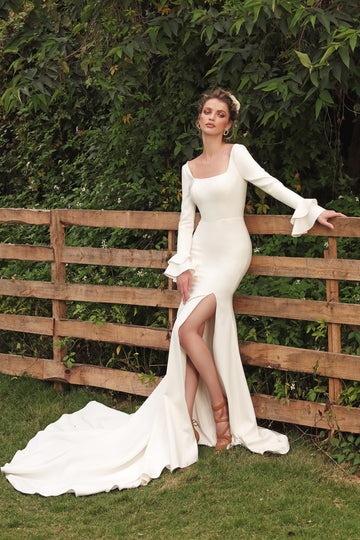The Symbolic Evolution of Bridal Colors Across Cultures
The Symbolic Evolution of Bridal Colors Across Cultures
Weddings are a tapestry of traditions, rituals, and attire, each woven with meaning and significance. One of the most fascinating elements of any wedding attire is the color of the bridal gown. As we explore the symbolic evolution of bridal colors across cultures, we can see how they reflect the values, beliefs, and customs of various societies. This article will delve into the historical backgrounds, cultural significance, and modern interpretations of bridal colors, showcasing their diverse meanings across continents.
The Importance of Color in Cultural Symbols
Colors play a pivotal role in symbolism around the world. From the fiery reds of luck in China to the pure whites of Western weddings, bridal colors often communicate deeper messages about love, purity, and fertility. Different cultures associate various meanings with colors, which can significantly affect a bride's choice of gown. Below, we present a table highlighting the meanings of popular bridal colors across different cultures:
| Color | Culture | Symbolism |
| White | Western countries | Purity, innocence |
| Red | China | Good luck, joy |
| Blue | Greece | Love, fidelity |
| Yellow | India | Happiness, prosperity |
| Green | Middle East | Fertility, growth |

A Closer Look at Bridal Colors in Different Cultures
1. White: The Western Tradition
In many Western cultures, the white bridal gown symbolizes purity and innocence. This tradition is largely traced back to Queen Victoria of England, who wore white for her wedding to Prince Albert in 1840. This choice was considered unconventional at the time, as brides formerly wore their best dresses regardless of color. Today, white remains the dominant color in many Western weddings, sparking further discussions about its symbolism and implications regarding societal expectations on purity.
2. Red: The Chinese Celebration
Contrary to the Western norm, red is the color of choice for brides in Chinese culture. It represents good fortune, happiness, and prosperity. Traditionally, Chinese brides wear a red qipao or a modern red gown adorned with gold embroidery. The color red is thought to ward off evil spirits and ensure a joyful marriage. In addition to red dresses, brides may also carry red umbrellas, symbolizing protection and happiness.
3. Blue: The Greek Connection
In Greece, blue is often associated with the evil eye and is believed to protect against misfortune. Brides may wear blue in their attire or incorporate the color within other elements of their wedding. This color embodies love and fidelity, making it a popular choice for brides seeking to symbolize their commitments to their partners.
4. Yellow: The Vibrancy of Indian Weddings
In India, yellow is a favored color for bridal wear as it symbolizes happiness, prosperity, and fertility. Often seen during the pre-wedding ceremonies, brides may wear vibrant yellow lehengas or sarees. The color not only signifies joy but is also closely linked to the rituals conducted before the wedding day, highlighting the significance of family and cultural heritage.
Modern Trends in Bridal Colors
As globalization continues to influence cultures, the traditions surrounding bridal colors are shifting. Modern brides are often inclined to explore colors outside their cultural norms, choosing shades that resonate personally rather than adhering strictly to tradition. This evolving landscape has birthed new trends, such as:
- Pastels: Soft shades like lavender, blush, and mint green are becoming increasingly popular, often signifying elegance and modernity.
- Bold Colors: Many contemporary brides choose vibrant colors like royal blue, crimson, or even black for a striking departure from the conventional white gown.
- Mixing Colors: Some brides opt for dresses that blend multiple colors or incorporate unique patterns, reflecting their individual style and identity.
Cultural Fusion in Wedding Attire
With the rise of multicultural weddings, bridal colors have begun to reflect an amalgamation of traditions. Couples from different cultural backgrounds are merging their heritage, allowing brides to experiment with various colors and designs. This fusion creates a dynamic wedding aesthetic and represents the unity and blending of families.
Tips for Choosing the Perfect Bridal Color
When selecting a bridal color, consider the following tips:
- Understand Cultural Significance: Research the meanings behind colors in your culture and your partner's culture to make an informed choice.
- Reflect Personal Style: Choose a color that resonates with your personality and captures the essence of your relationship.
- Think About the Venue: Consider the backdrop of your wedding venue, as this can influence how colors appear in photographs.
- Consult with Your Partner: If you and your partner come from different cultures, discuss color choices collaboratively to honor both traditions.
Conclusion
The symbolic evolution of bridal colors across cultures highlights the dynamism and richness of wedding traditions around the globe. As cultural boundaries continue to blur and individual expression becomes paramount, brides are empowered to choose colors that genuinely resonate with them, regardless of conventional practices. As you embark on your wedding planning journey, remember the layer of meaning behind your color choices, embrace your heritage, and let your personality shine through. Choose a color with significance to you, whether steeped in tradition or a modern twist. Happy wedding planning!
